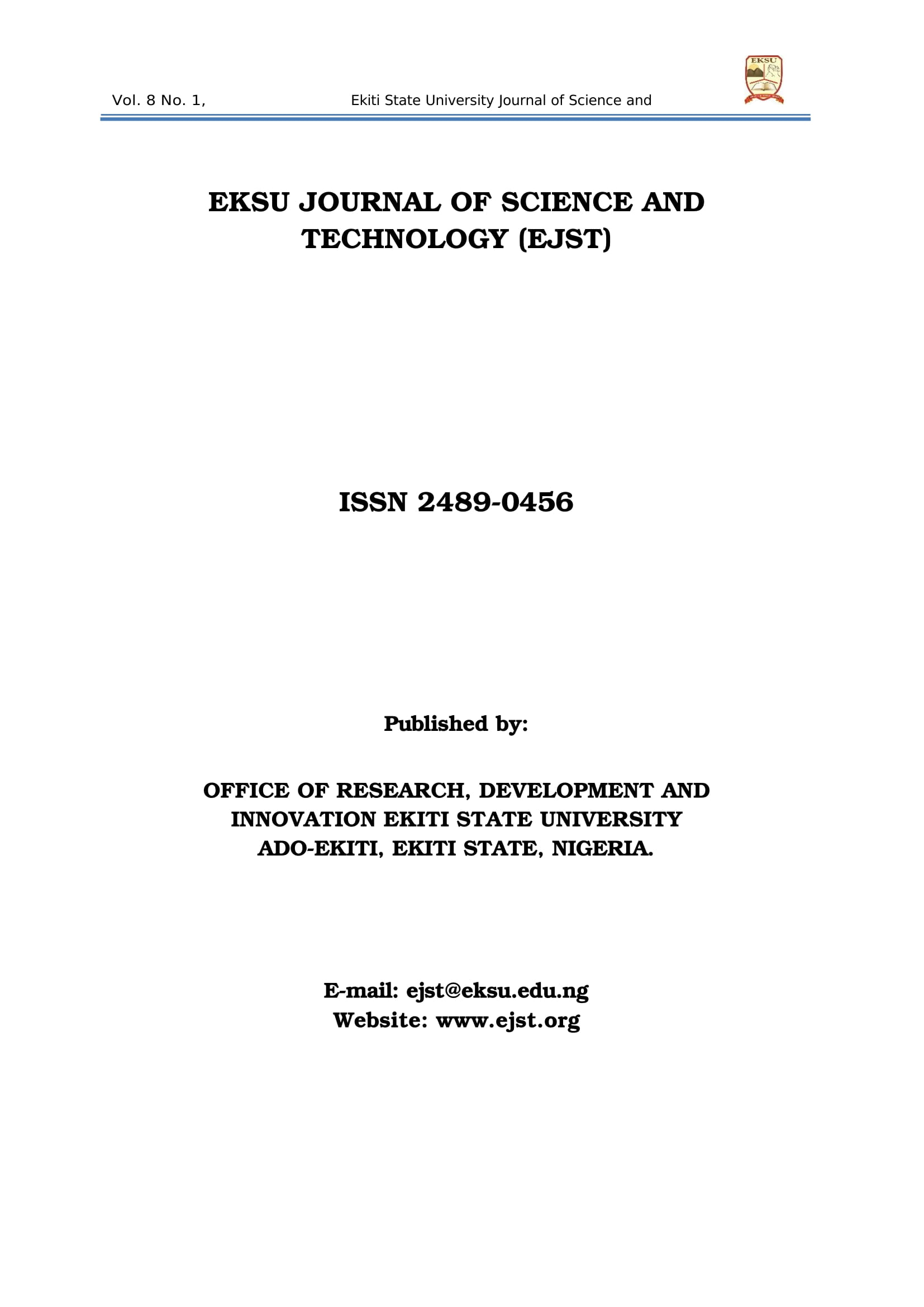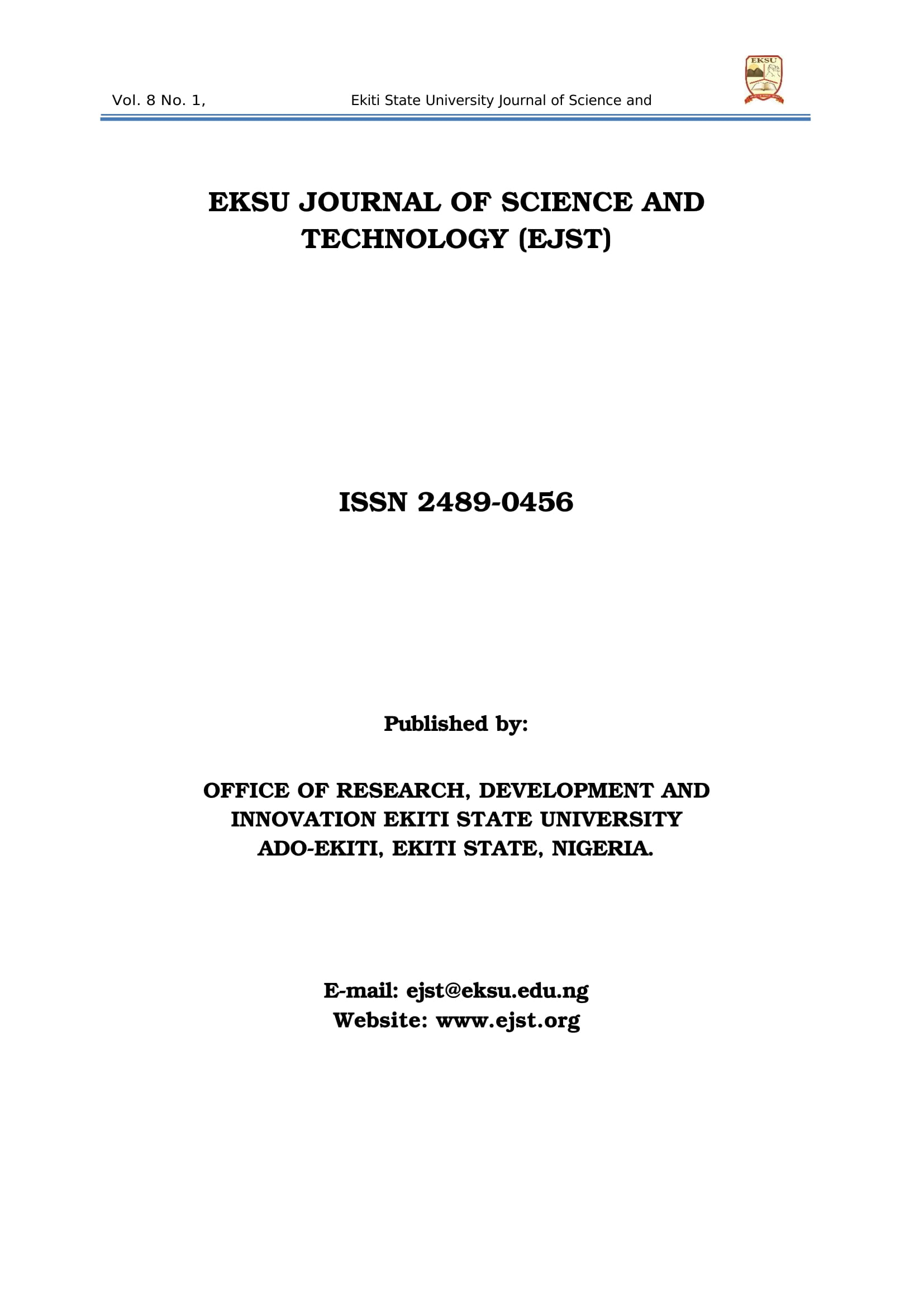Vol. 8 No. 1 (2023): EKSU JOURNAL OF SCIENCE AND TECHNOLOGY (EJST)

EDITORIAL POLICY
EKSU Journal of Science and Technology (EJST) is a biannual Journal published by Ekiti State University, Office of Research, Development and Innovation. The Journal aims at periodically exhibiting and advertising the potential of research results within and outside the university as well as promoting dissemination of intellectual publications generally. The Journal, which is multidisciplinary and multicultural in nature covers the publication of original findings in Science and Engineering. It serves as a platform for academics, researchers, professionals, practitioners and students in the Science and Technology field to impart and share knowledge in the form of high quality practical, empirical and theoretical research papers, case studies, literature review and book reviews etc. from all over the world.
CALL FOR PAPERS
ABOUT EJST
Ekiti State University has been publishing journals at the Faculty, Departmental levels and University. As part of the mandate of Ekiti State University, Office of Research, Development and Innovation (EKSUORDI) to periodically exhibit and advertise the potentials of research results within the University as well as promoting the dissemination of intellectual publications generally, EKSUORDI announces the publication of a Science and Engineering based University journal. EKSU Journal of Science and Technology (EJST). The Journal which is an international academic journal provides a platform for natural, agricultural, environmental, medical scientists and engineers as well as technologists to share and expand the knowledge of scientific advancements in the myriad disciplines of science and engineering and applied aspects/fields.
- AIMS AND FOCUS
EKSU Journal of Science and Technology aims to publish and disseminate original papers that:
- address ethical or socioeconomic issues relating to modern agricultural and environmental science as applicable to developing countries;
- contribute to the development of science and technology for economic advancement;
- innovate near market or market ready technologies and processes
- publish research findings on current topical issues in science and engineering of interest to both public and private sectors.
- SCOPE
EJST will publish peer reviewed original research and critical reviews on agriculture, human nutrition or human health, scientific or technological information, with particular emphasis on interdisciplinary studies that explore the intersection of agriculture, science, engineering and environment.
- DOMICILIATION
The Journal is domiciled in the Office of Research, Development and Innovation, Ekiti State University, Ado-Ekiti.
- SECTION
In order to encourage researchers to publish their research articles in the field of Science and Technology, the following sections are introduced:
Section A - (Agricultural Science) Section B - (Natural Sciences)
Section C - (Engineering and Technology) Section D - (Medical Sciences)
Section E - (Environmental Sciences)
- FREQUENCY
The frequency of the journal is bienial.
- REVIEW PROCESS
There shall be a review process of manuscripts by independent referees who are conversant and versatile in the pertinent subject area.
Authors should strive for maximum clarity of expression. Material which is not essential to the continuity of the text (e.g., proofs, derivations, or calculations) should be placed in Appendices Materials which have been previously copyrighted, published, or accepted for publication will not be considered for publication in the journal.
The editorial board is highly committed to the quick review process of the paper, but not with the sacrifice of the right judgement of a paper. The review process takes maximum of six weeks.
- PROCEDURE FOR MANUSCRIPT ACCEPTANCE FOR PUBLICATION
The manuscript would be sent to three (3) reviewers, of which two (2) of the reviewers’ comment must be positive before acceptance, and the authors would have to effect all the corrections pointed out by the reviewers in the reviewers form.
- PAGE CHARGE PROOF AND REPRINTS
Manuscript should be submitted as e-mail attachment to the corresponding author who will be contacted via e-mail on the corrections of the manuscript. This volume of EJST is sponsored by Tertiary Education Trust Fund (TETFund). With the exception of minor typographical errors, no changes will be made on the manuscript at the proof stage. A hard copy of the appropriate section and five (5) off prints would be provided for the corresponding author of each paper.
- ACCESSIBILITY AND SUBSCRIPTION
EJST will be available both in print (hardcopy) and online (softcopy) format at www.academix.ng Online accessibility is by subscription. Information on purchase of any section, biennial, quarterly or annual subscription can be obtained by contacting EKSUORD.
- ARTICLE TYPES
Regular Articles, short communication, and review will be acceptable for publication in the journal.
- INFORMATION /GUIDES FOR AUTHOR
- The title page should bear the author’s full names and affiliation of the names of corresponding author along with phone, fax and e-mail Present addresses of authors should appear as a footnote.
- Abstract should be informative and self-explanatory. Should be 100-200 words in Abstract should be written in past tense-standard nomenclature should be used.
Abbreviation should be avoided and no literature should be cited. List of nonstandard abbreviation should be added.
- Manuscript should not exceed 15-20
- Introduction should provide a clear statement of the problem, the relevant literature on the subject, and the proposed approach or solution.
- Materials and methods should be complete enough to allow experiments to be reproduced, and results written in past tense should be presented with clarity
- Results should be explained, but largely without referring to the
- Discussion should interprete findings in view of results obtained in present and past studies on the topic.
- Conclusion should be stated in few sentences at the end of the
- Acknowledgment of people, grant, funds should be
- Manuscript should be typed in double-line spacing with microsoft word on A4 size paperusing 12 font size (Time New Roman)
- Table should be kept to a minimum, and are to be typed double line-spaced throughoutincluding headings and The same data should not be presented in both table andgraph form or repeated in the text.
- Figure legend should be typed in numerical order on a separate
- Graphics should be prepared using applications capable of generating high resolution Gif, TIFF, JPEG or Microsoft powerpoint before pasting in microsoft world manuscript
- In the text, a reference identified by means of an author’s name should be followed by the date of the reference in parentheses. When there are more than two authors’ names mentioned, it should be the first author followed by et al. In the event that an author cited has two or more works published during the same year, the reference, both in text and in the reference list, should be identified by a lower case letter like, a’ and, b’ after the date to distinguish the works. Example: Abayomi (2000), Agindotan et al. (2003), (Kelebeni, 1983), (Usman and Smith, 1992), (Chege, 1998; Chukwura, 1987 a, b; Tijani
1993, 1995), (Kumasi et al., 2001).
References should be listed at the end of the paper in alphabetical order. Articles in preparation or articles submitted for publication, unpublished observations, personal communications date, etc, should not be included in the reference but should only be mentioned in the article text (e.g. A. Kingory, University of Nairobi, Kenya, personal communication, date) Journal names are abbreviated according to chemical abstracts.
Authors are fully responsible for the accuracy of references. Example: Chikere C. B, Omoni
- T, and Chikere B. O. (2008). Distribution of potential nosocomial pathogens in a hospital environmental. Afr. J. Biotechnol. 7:3535 - 3539.
Moran G. J; Amii R. N; Abrahamian F. M, Talan D. A. (2005), Methicillin resistant staphylococcus aureus in community-acquired skin infections. Emeg. Infect. Dis. 11: 928-930.
Pelczar J. R. Harley J. P., Klein D. A. (1993) Microbiology: Concept and applications, McGraw-Hill Inc., New York, pp 591-603.
- SHORT COMMUNICATION: Short communication are limited to a maximum of two figures and one They should present a complete study that is more limited in scope than is found in full length papers. The items of manuscript preparation listed above apply to short communications with the following differences:
- Abstracts are limited to 100 words;
- Instead of a separate materials and methods section, experimental procedures may be incorporated into figure legends and table footnotes;
- Results and discussion should be combined into one
COPYRIGHT
Submission of manuscript implies that the work described has not been published before, and thatit is not under consideration for publication elsewhere. If and when the manuscript is accepted forpublication, the authors will agree to automatically transfer the copyright to the publisher.
CORRESPONDENCE:
Please direct all correspondence(s) to:
Deputy Director (Research),
Office of Research, Development and Innovation, Ekiti State University,
PMB 5363, Ado-Ekiti.
Phone: +2348064182009
E-mail: ejst@eksu.edu.ng
The Administrative Officer
Office of Research, Development and Innovation, Ekiti State University,
PMB 5363, Ado-Ekiti.
Tel: +2348038850252
- EDITORIAL BOARD
Shall review manuscripts accepted and publish them within 3 months after submission. The Board comprises of Chairman, Editor-in Chief, Managing Editor and Editorial Advisers drawn from cognate disciplines, industries, research institutes, professionals, educators and policy makes within and outside the country.
Chairman
Prof. Richard Odunayo Akinyeye
Director,
Office of Research, Development and Innovation (ORDI), Ekiti State University, Ado-Ekiti. richard.akinyeye@eksu.edu.ng
Phone: +234 - 7032770985
Editor-in-Chief:
Prof. Temitope Jegede
Department of Fisheries and Aquaculture Management, Faculty of Agriculture Sciences,
Ekiti State University, Ado-Ekiti. temitope.jegede@eksu.edu.ng
Managing Editor
Dr. Olayinka Abidemi Ibigbami
Department of Chemistry, Faculty of Science,
Ekiti State University, Ado-Ekiti. olayinka.ibigbami@eksu.edu.ng
Administrative Officer
Mr. O. W. Ojo
Office of Research, Development and Innovation, Ekiti State University,
P.M.B. 5363, Ado-Ekiti.
Member
- E. A. Okunade Department of Civil Engineering, Faculty of Engineering,
Ekiti State University, Ado-Ekiti.
- Deji Fasuyi, Department of Animal Science, Faculty of Agriculture Science, Ekiti State University, Ado-Ekiti. ayodeji.fasuyi@eksu.edu.ng
- Stephen Olusola Ojeniyi
Department of Crop, Soil and Pest Management, The Federal University of Technology,
Akure.
- (Mrs.) Modupe Janet Ayeni
Department of Plant Science and Biotechnology, Faculty of Science,
Ekiti State University, Ado-Ekiti. modupeayeni@eksu.edu.ng
- Joao Batista Rocha, Universidade Federal De Santa Maria, Santa Maria, Brazil.
E-mail:
- M. O. Aremu Department of Chemistry, Federal University Wukari, Wukari, Taraba State. lekearemu@gmail.com
- Ayo Omotosho Department of Paediatrics, College of Medicine, University of Ilorin,
Ilorin, Kwara State. E-mail:
- Onundi, Lateef Olorunfemi
Department of Civil & Water Resources Engineering, University of Maiduguri,
P.M.B. 1069, Maiduguri, Bornu State. E-mail:
- Stephen Olofinmihan Elesha Department of Anatomic Pathology, Niger Delta University,
Amusambo, ‘Bayelsa State.
E-mail:
- Dennis A. Meritt Jr. Department of Biological Sciences, Depaul University, 2325,
North Clifton Avenue, Chicago, II, 60614 E-mail:
- Olusola O. Agbede
College of Agricultural Sciences, Department of Crop and Soil Sciences, Landmark University,
PMB 1001, Omu-Aran,
Kwara State, Nigeria.
+2348037337617
- Mohibullah Mohibullah
Assistant Professor, Department of Geology, University of Balochistan, Quetta, Pakistan.
Cell: +92(0)3339323099
E-mail: mohibgeo1@yahoo.com
- Fadiya Suyi Lawrence Department of Geology, Obafemi Awolowo University, Ile-Ife, Osun State, Nigeria.
+2348033320230
- J. F. Olorunfemi Department of Geography and Environmental Management, Faculty of Social Sciences, University of Ilorin,
PMB 1515, Ilorin, Kwara State, Nigeria.
+2348037208875


